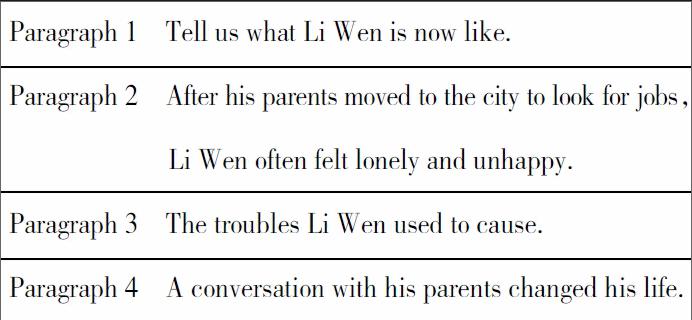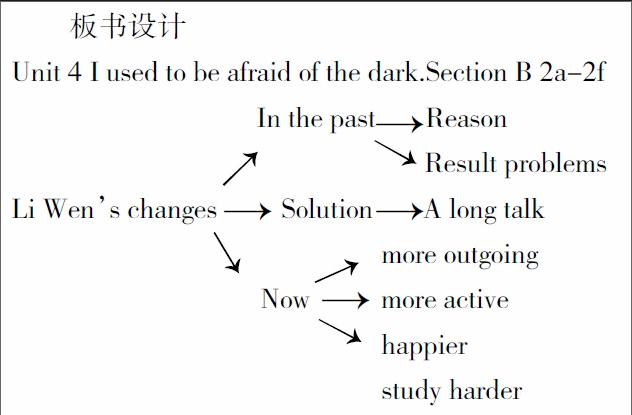Unit 4 I used to be afraid of the dark.(Section B 2a—2f)教学设计与反思
2017-10-30孙黎张丽华
孙黎+张丽华



(本课选自人教版義务教育课程标准实验教科书《英语》九年级。)
教材分析
该单元话题是谈论我们所发生的变化(How we have changed)。 Section B 部分在Section A 的话题基础上进行延伸和拓展,由描述人物性格,外貌变化转向讨论人物行为习惯、爱好;在语言上,该部分除了进一步巩固Section A 所学重点语言内容外,还复习巩固了有关行为习惯及爱好的短语,同时还通过语篇呈现了其他词语;从技能上看,该部分由听、说转向综合性的听、读、写的训练;从学习策略上看,教材侧重训练学生利用上下文线索进行推导判断,确认语句位置及解读词语含义的阅读策略及能力。另外,Section B 的阅读部分介绍了一位乡村少年的成长故事,目的在于唤起学生的关爱之心,使其懂得亲情的可贵,理解父母的责任,并能在成长的道路上注重心理健康。
教学目标
1.语言知识目标
掌握单词:seldom,influence,absent,fail,exactly,context,examination等。
正确使用下列常用表达:boarding school;in person;take pride in; be proud of。
复习巩固有关行为习惯及爱好的短语,通过语篇学习其他词汇。
2.语言技能目标
指导学生掌握阅读技巧,快读,细读。
能根据上下文语境推测生词、短语以及篇章的含义。
3.学习策略
能利用上下文线索进行推断判断,确认语句位置及解读词语含义的阅读策略及能力。
能根据篇章内容的前后逻辑联系判断缺失信息。
能灵活运用不同的短语表达同样的含义。
4.情感态度
教育学生要正视过去。
教育学生遇到困难时要积极找寻解决办法,懂得感恩父母。
5.文化意识
自我完善(Self-improvement)。
教学重、难点
教学重点:阅读篇章中出现的新单词、新短语的意义。阅读策略:Using Context在阅读篇章中的应用,以及根据篇章内容的前后逻辑联系判断缺失信息。
教学难点:运用阅读策略根据上下文线索断判断,确认语句位置及解读词语含义的阅读策略及综合语言运用能力。
教学步骤
●Step One Leading-in and new words
1.Greeting and leading-in
T:Hello, everyone. This lesson well learn English together. I am from Mu Danjiang No.16 Middle School. My name is Sun Li,and you can call me Ms Sun. Dont be nervous. You are the best. Are you ready?Class begins.Good morning,class!
Ss:Good morning, Ms Sun.
T:Before the class,I want to ask you,did you use to have problems in school? If you have problems,did you talk with your parents?
S1:Yes,I did,and I always talked with my mother.
S2:Yes,I did,but I didnt like to talk to my parents.
T:I think you are lucky. If you have problems, you have someone to share your problems with. But some children are not as lucky as you are. If they have problems, they have no parents to help them. They are stay-at-home children.
T:(Show some pictures about the stay-at-home children) What do you think of them?
S1:They miss their parents.
S2:They feel lonely and unhappy.
T:Yes.You are so clever. OK.Today lets read a passage about a stay-at-home child.Lets learn Unit 4 I used to be afraid of the dark. Section B 2a-2f. (Write “Unit 4 I used to be afraid of the dark. Section B 2a-2f” on the blackboard.)
2.New words learning
T:Please look at the pictures. Where are their parents?
Their parents seldom come back home. seldom adv. 很少;不常.
Some students may fail some examinations. Fail v. 失败. examination n. 考试.endprint
Some students still study hard. Their parents take pride in them. Take pride in= be proud of 為……而骄傲.
This is exactly what they need. exactly adv. 确切地.
T:Follow me to read the new words.
Ss:...
T:Good job.
设计意图:利用两个和学生息息相关的问题导入新课,贴近学生生活又顺理成章,再利用留守儿童图片让学生了解阅读材料背景,通过切身的感受激发学习兴趣。直观的图片和合理的句子引出本节课的重点单词,让学生在情境中理解单词,降低学习单词的乏味性,充分调动了学生的积极性。
●Step Two Pre-reading
T:For the stay-at-home children,they may have many problems. If they dont have parents to take care of,they have to look after their sick grandparents, they have to work in the field, they may fight with their classmates, and they may hate studying. Today, well read a passage about a stay-at-home boy, his name is Li Wen. What problems do you think he might have?
(Students look at the picture and the title of the passage to predict.)
T:What problems do you think he might have?
S1:He used to hate studying and fail his exam.
S2:He might have problems in study.
S3:...
设计意图:在正式阅读文章之前,根据书上给出的2a的问题让学生根据直观的图片和标题猜测文章所要讲述的大概内容,不同的学生会有不同的想法,表达不同但是意思相同,这样不仅帮助学生复习了之前学习的本单元的功能句型,也让学生能对文章有一个粗浅的理解,让学生产生了想要进一步阅读了解更多内容的想法。
●Step Three While-reading
1.Fast reading
T:Li Wen used to have some problems, do you want to know what happened to him? Read the text for the first time, please finish 2b, put the missing sentences A to D in the correct places.
设计意图:快速浏览文章,还原句子到文章当中,此任务设置在文章阅读的第一个环节,把文章遗失的句子先补充完整,扫清由于信息缺失对下一步阅读造成的障碍,也让学生通过句子的还原充分理解文章上下文的联系,培养了学生快速阅读的能力。
T:We have found out the missing sentences, and please tell me, how many paragraphs are there in the passage?
Ss:Four.
T:Yes. Next, read the passage again. Draw lines to match the main idea of each paragraph.
Reading strategy:Skimming.
设计意图:通过之前的还原句子的任务设置,学生已经快速浏览了一遍文章,对文章的内容已有了大概的了解,此项任务采用跳读的阅读策略,只读每段首尾句找出段落大意,更加深了学生对文章内容的理解。
2.Careful reading
T:We have read the passage twice, and we have known the general meaning of the passage, next, lets read carefully to answer some detail questions about the passage.
(1) Paragraph 1.
T:Read the first paragraph, and then answer the questions:
Q1:Why did Li Wens parents leave home?
Q2:How did Li Wen feel after his parents left?
(2) Paragraph 2.
T:Read the second paragraph and finish off activity 2c.Underline the problems that Li Wen used to have.
(3) Paragraph 3 and 4.
T:Read the third and the fourth paragraph and then answer the question:What does Li Wen think of their parents after the talk?endprint
A. They are busy and dont care him at all.
B. Parents care him very much and are proud of him.
C. They are angry with him and dont love him.
设计意图:通过细读文章各段并设置每段相适应的问题,帮助学生理解各段的细节问题,这样分段落进行阅读教学,在一定程度上又降低了文章的难度,易于学生理解。
(4) Read the whole passage carefully again, show them the reading strategy:using context.
Reading strategy:Using context. This means “using the sentence context may help you guess and learn the meanings of new words and phrases.”
For example, what does the bold word influence mean in the second paragraph? Help students to guess the meaning of it according to the context.
T:What does the bold word influence mean in the second paragraph?
Ss:No.
T:You can use the reading strategy to guess the meaning according to the context. For example, the phrase before influence, Li Wens unhappiness and the sentence after influence, he became less interested in studying. They show that the meaning of this word—影響. Next, finish off 2d.Use clues from the passage to help you guess the meaning of the words in the box.
设计意图:本篇阅读我们重点学习的就是根据上下文语境猜测文章中单词和词组意思的阅读策略,根据举例,学生会对这一阅读策略有更进一步的了解,通过练习,学生会通过自己的理解牢固地掌握这一策略,为自己日后阅读能力的进一步提高打下基础。
(5) Read the whole passage carefully again and fill in the blanks according to the passage.
设计意图:学生通过之前的快读、分段读、细读等已经对文章有了完全的了解,本部分把文章的基本内容梳理成框架即思维导图的形式,让学生再一次细读文章之后完成表格的内容,这样做,可以让学生把之前的碎片整合起来,让学生真正地把握文章的整体脉络,达到了之前预设的教学目的。
●Step Four Post-reading
1.Language points
① seldom adv. 很少,不常
例:He is seldom late for school.
He seldom goes out after ten oclock.
② influence v.& n. 影响 =change
例:Lu Xuns works influenced/ changed me.
have an influence on sth. 对……有影响
例:My teacher has a good influence on me.
③ absent adj. 缺席
be absent from sth. 缺席……=miss
例:The boy was absent from/ missed classes because he was ill.
④ in person 亲身;亲自= by oneself = on ones own
例:She advised them to talk with their son in person.
⑤ pride n. 骄傲
proud adj. 骄傲的
take pride in = be proud of 为……骄傲
例:We take pride in our homeland.= We are proud of our homeland.
设计意图:语言点的讲解虽然不是阅读课的重点,但是有些知识点对篇章的理解起到至关重要的作用,这些知识点不仅要让学生知道其在本篇文章中的意义,更要让学生在理解单词词组意思的同时学会使用它们。
2.Discussing
T:Work in four.You are Li Wen, your parents are working in the different city, you have some problems, what will you and your parents say when they come back?endprint
设计意图:阅读后讨论的环节让学生分角色去讨论如果他们是文章中的主人公和他的父母,在他们遇到这样的问题时他们会说什么,他们都会怎么做。让学生处在真实的情境中,不仅可以让学生练习之前已学过的功能句型,也有利于帮助学生在阅读后挖掘文章深层次的启示。
●Step Five Emotion teaching
T:1.Why do Li Wens parents leave the countryside to the city to find jobs? 2.Why do they want to earn much more money? 3.What should children do if their children leave them to the city to look for jobs?
Ss:...
设计意图:通过情感态度价值观的培养,让学生学会感恩,理解父母,努力学习。
●Step Six Summary and homework
T:What have we learned?
S1:I learned how to read the text.
S2:I learned some useful words and phrases.
Ss:...
T:Homework:1.Finish 2e and 2f carefully on your book. 2.Role-play the conversation between Li Wen and his parents after class.
T:Class is over, goodbye class.
Ss:Goodbye, teacher.
設计意图:完成书上的内容2e和2f需要再读文章,再读文章有利于学生更好地理解课文,复习课上所学过的东西,为下节课的写作课做好了铺垫。
板书设计
Unit 4 I used to be afraid of the dark.Section B 2a-2f
In the past Reason
Result problems
Li Wens changes Solution A long talk
more outgoing
Now more active
happier
study harder
评析:
人教版新目标英语九年级“Unit 4 I used to be afraid of the dark(Section B 2a-2f)”是一节典型的阅读课。根据教学重难点及情感态度价值观目标,对这节阅读课评析如下:
一、阅读方法策略指导明确到位
授人以鱼,不如授人以渔。现代教学更重视培养学生的自我发展能力,那么作为英语老师,任务是:“Teach students how to learn English”,而不仅是“Teach students English”。教师在教学环节的设计上把阅读策略——Using context这一环节作为重点,呈现这一阅读策略时,先给出了它的定义,让学生明确这一阅读策略到底指的是什么,告诉学生怎样根据上下文去猜测目标单词或短语的意思,让学生充分了解到底怎样去运用这一阅读策略,达到了教授阅读策略与方法的真正目的。在授课过程中,学生对这一阅读策略的理解和运用也相当到位,可以说教授此环节是这节课的一大亮点,不仅突出了本节课的教学重难点,也帮助学生真正掌握了一项新的阅读策略。
二、“整体—部分—整体”阅读环节设计有效帮助学生阅读
英语阅读在英语教学中无疑有着举足轻重的作用,阅读亦为英语学习输入的重要手段。初中英语教材编排中,每个单元都设置了三部分的阅读教学材料:Section A中的3a,Section B 中的2b,Grammar focus 或Self-check中穿插的一些小阅读,等等。九年级正面临中考,试卷中阅读的比例越来越重,是中考的重点、难点。怎样上好一节阅读课,怎样激发学生的阅读兴趣,让孩子爱上阅读,是每个老师在设计自己的阅读课时都应认真仔细思考的问题。
该节阅读课,教师根据文章的内容以及学生的层次,设置了“整体—部分—整体”的阅读任务。第一步,整体阅读,快读两遍文章,让学生通过还原句子,匹配段落大意这两项任务先对文章进行大体的了解。然后是第二步,分段阅读,细读文章的四段,通过设置不同形式的问题让学生对文章细节进行更深一步的了解。最后是第三步,整体阅读,再次细读整篇文章,最后通过框架式思维导图的形式将整篇文章的脉络梳理清楚,让学生再一次对文章有了更深一层次的认识。最后的思维导图的设置是本节课的另一大亮点,本篇文章的内容以这样的形式重新呈现在了学生的面前,让学生觉得思路很清晰,也有利于教师突破教学的重难点。
有一点不足的是,在阅读问题环节的设置上,教师的设置比较简单,如学生的理解能力和接受能力比较强的话,问题的难度、样式可以适当增加,内容也可以相应地增加。
三、情感态度价值观培养——体会亲情可贵,注重心理健康
该节课的阅读文本介绍了一位乡村少年的成长故事,学生们可能有和文章主人公相似的经历,父母不在身边,遇到问题后不知道如何去解决等。学习的内容和自己的生活相关,自然会吸引他们学习的注意力,激发学生的学习兴趣之后再进行学习,会事半功倍。
该节阅读课在情感态度价值观的培养上也主要是让学生在遇到问题时知道怎么样处理,去理解父母。我觉得,一节课下来,也给学生带来了许多反思。教师在教学过程中始终引导学生感恩父母,并让他们在课堂上将这种情感表达出来,使学生感受到温情的萦绕,产生丰富的情感和积极的情绪体验,以此为基础,拥有对知识的渴求,对亲情的珍惜,对父母的感恩以及对生活的热爱。乐于学习也不再是一句空话,而会演变为他们为理想而付出的实践,更明确了他们学习的动机。endprint
